alarm OLDSMOBILE SILHOUETTE 2003 Owners Manual
[x] Cancel search | Manufacturer: OLDSMOBILE, Model Year: 2003, Model line: SILHOUETTE, Model: OLDSMOBILE SILHOUETTE 2003Pages: 466, PDF Size: 21.55 MB
Page 92 of 466
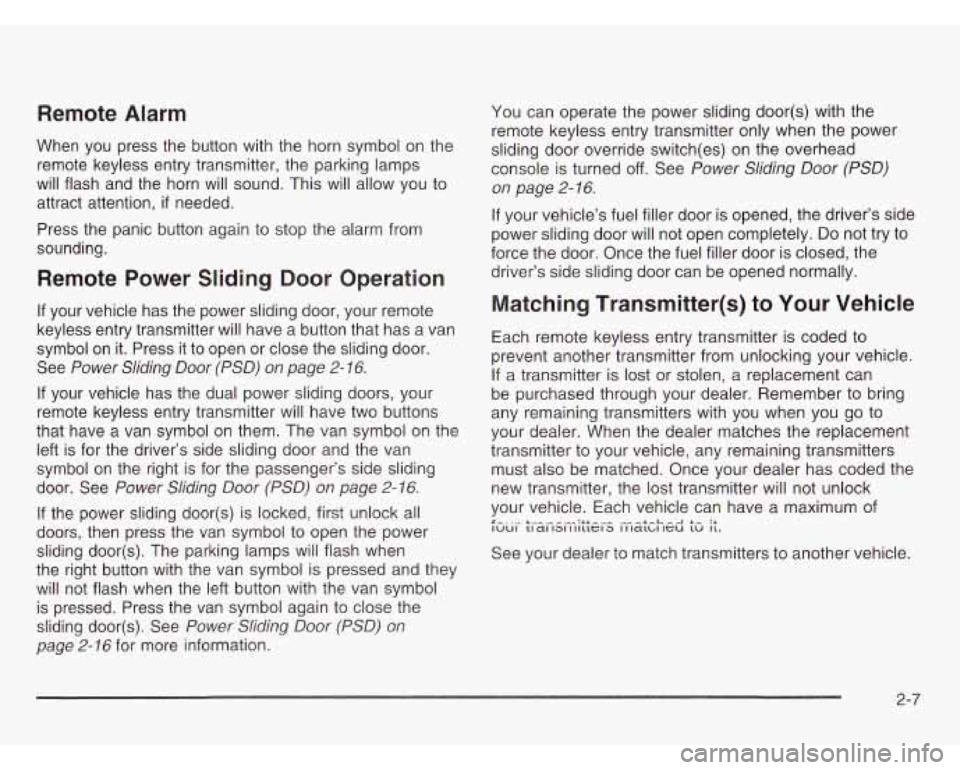
Remote Alarm
When you press the button with the horn symbol on the
remote keyless entry transmitter, the parking lamps
will flash and the horn
will sound. This will allow you to
attract attention,
if needed.
Press the panic button again to stop the alarm from
sounding.
Remote Power Sliding Door Operation
If your vehicle has the power sliding door, your remote
keyless entry transmitter will have a button that has a van
symbol on it. Press it to open or close the sliding door.
See
Power Sliding Door (PSD) on page 2- 16.
If your vehicle has the dual power sliding doors, your
remote keyless entry transmitter will have two buttons
that have a van symbol on them. The van symbol on the
left is for the driver’s side sliding door and the van
symbol on the right is for the passenger’s side sliding
door. See
Power Sliding Door (PSD) on page 2-16.
If the power sliding door(s) is locked, first unlock all
doors, then press the van symbol to open the power
sliding door(s). The parking lamps will flash when
the right button with the van symbol is pressed and they
will not flash when the left button with the van symbol
is pressed. Press the van symbol again to close the
sliding door(s). See
Power Sliding Door (PSD) on
page 2- 16 for more information. You
can operate the power sliding door(s) with the
remote keyless entry transmitter only when the power
sliding door override switch(es) on the overhead
console is turned
off. See Power Sliding Door (PSD)
on page
2- 16.
If your vehicle’s fuel filler door is opened, the driver’s side
power sliding door will not open completely.
Do not try to
force the door. Once the fuel filler door is closed, the
driver’s side sliding door can be opened normally.
Matching Transmitter(s) to Your Vehicle
Each remote keyless entry transmitter is coded to
prevent another transmitter from unlocking your vehicle.
If a transmitter is lost or stolen, a replacement can
be purchased through your dealer. Remember to bring
any remaining transmitters with you when you go to
your dealer. When the dealer matches the replacement
transmitter to your vehicle, any remaining transmitters
must also be matched. Once your dealer has coded the
new transmitter, the lost transmitter will not unlock
your vehicle. Each vehicle can have a maximum of
+^..I .L .----- :.LL--- --L-L^--I I- :A IUUI LI a1 131 I IILLGI 3 I I I~LCII IGU LV 11.
See your dealer to match transmitters to another vehicle.
2-7
Page 112 of 466
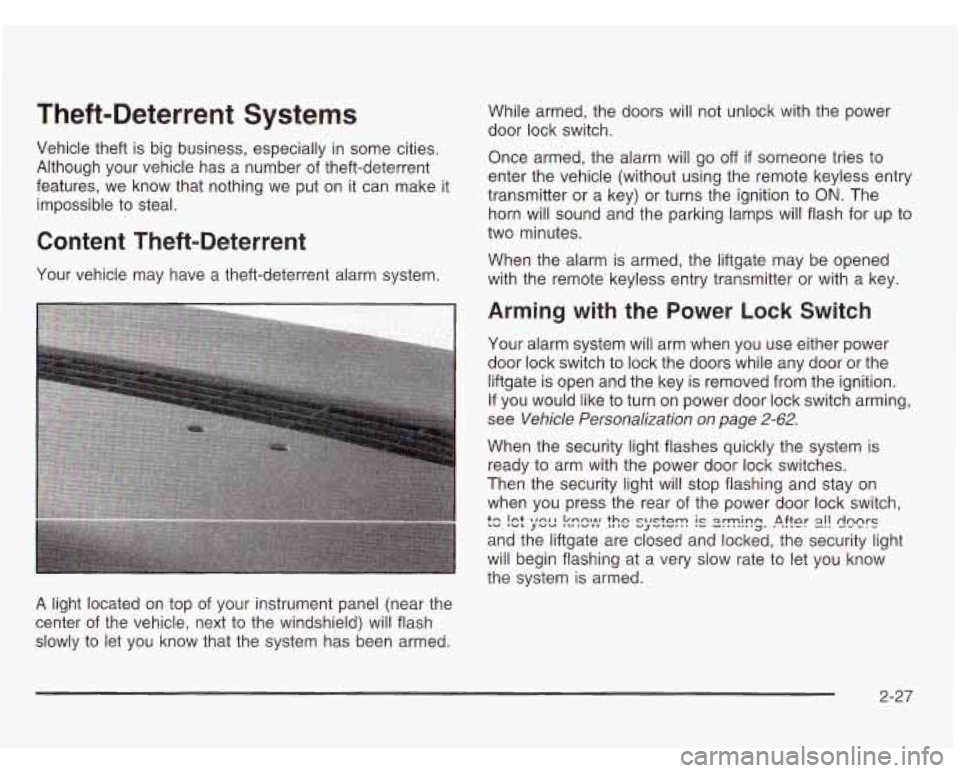
Theft-Deterrent Systems While armed, the doors will not unlock with the power
door lock switch.
Vehicle theft is big business, especially in some cities.
Although your vehicle has a number of theft-deterrent Once
armed, the alarm will go
off if someone tries to
enter the vehicle (without using the remote keyless entry
features, we know that nothing we put on it can make it
transmitter or a key) or turns the ignition to ON. The
impossible to steal. horn will sound and the parking lamps will flash for up to
Content Theft-Deterrent
Your vehicle may have a theft-deterrent alarm system. two minutes.
When
the alarm is armed, the liftgate may be opened
with the remote keyless entry transmitter or with a key.
Arming with the Power Lock Switch
Your alarm system will arm when you use either power
door lock switch to lock the doors while any door or the
liftgate is open and the key is removed from the ignition.
If you would like to turn on power door lock switch arming,
see
Vehicle Personalization on page 2-62.
When the security light flashes quickly the system is
ready to arm with the power door lock switches.
Then the security light will stop flashing and stay on
when you press the rear of the power door lock switch,
and the liftgate are closed and locked, the security light
will begin flashing at a very slow rate to let you know
the system is armed.
tc ]et ;‘cs k~s;~i the syste~ is srm.jnn 3- ‘ Aftnr .‘--. E!! &mrs
A light located on top of your instrument panel (near the
center of the vehicle, next to the windshield) will flash
slowly to let you know that the system has been armed.
2-27
Page 113 of 466
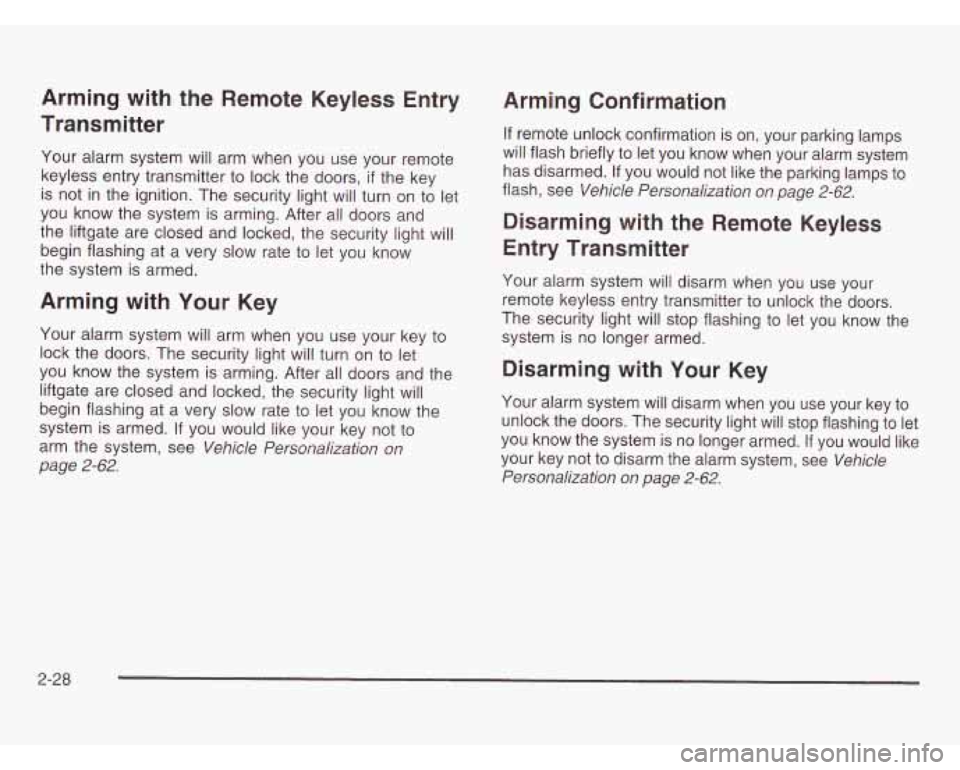
Arming with the Remote Keyless Entry
Transmitter
Your alarm system will arm when you use your remote
keyless entry transmitter
to lock the doors, if the key
is not in the ignition. The security light will turn on to let
you know the system is arming. After all doors and
the liftgate are closed and locked, the security light will
begin flashing at a very slow rate
to let you know
the system is armed.
Arming with Your Key
Your alarm system will arm when you use your key to
lock the doors. The security light will turn on to let
you know the system is arming. After all doors and the
liftgate are closed and locked, the security light will
begin flashing at a very slow rate
to let you know the
system is armed. If you would like your key not
to
arm the system, see Vehicle Personalization on
page 2-62.
Arming Confirmation
If remote unlock confirmation is on, your parking lamps
will flash briefly
to let you know when your alarm system
has disarmed. If you would not like the parking lamps
to
flash, see Vehicle Personalization on page 2-62.
Disarming with the Remote Keyless
Entry Transmitter
Your alarm system will disarm when you use your
remote keyless entry transmitter to unlock the doors.
The security light will stop flashing
to let you know the
system is no longer armed.
Disarming with Your Key
Your alarm system will disarm when you use your key to
unlock the doors. The security light will stop flashing to let
you know the system is no longer armed. If you would like
your key not
to disarm the alarm system, see Vehicle
Personalization on page 2-62.
2-28
Page 154 of 466
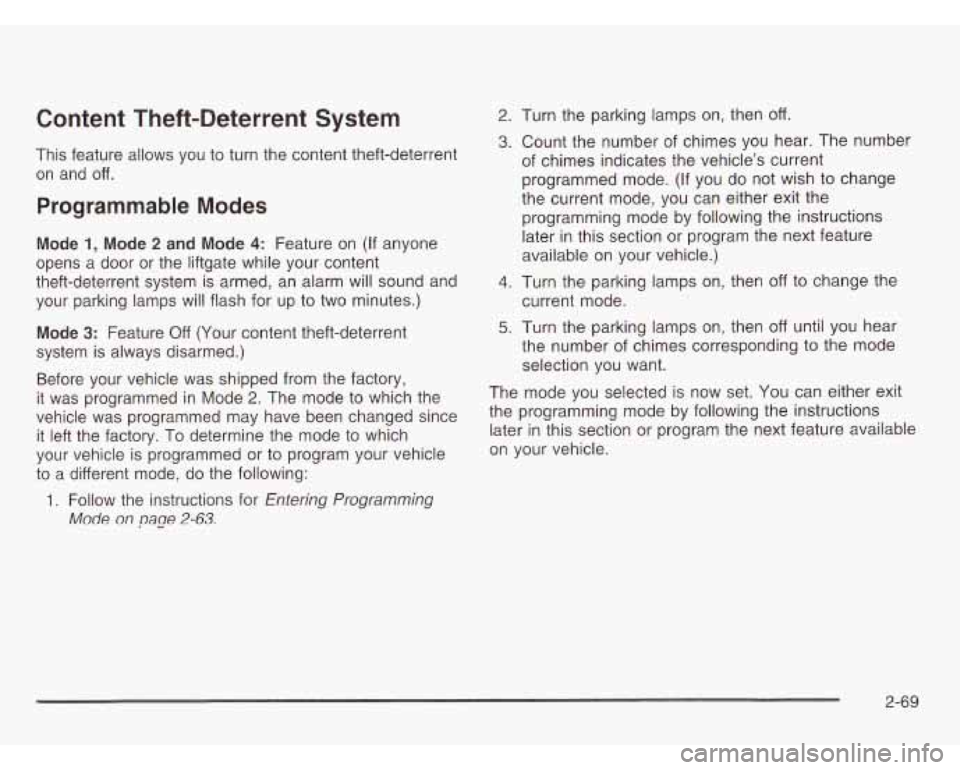
Content Theft-Deterrent System
This feature allows you to turn the content theft-deterrent
on and off.
Programmable Modes
Mode 1, Mode 2 and Mode 4: Feature on (If anyone
opens a door or the liftgate while your content
theft-deterrent system is armed, an alarm will sound and
your parking lamps will flash for up to two minutes.)
Mode 3: Feature Off (Your content theft-deterrent
system is always disarmed.)
Before your vehicle was shipped from the factory,
it was programmed in Mode
2. The mode to which the
vehicle was programmed may have been changed since
it left the factory. To determine the mode to which
your vehicle is programmed or to program your vehicle
to a different mode, do the following:
2. Turn the parking lamps on, then off.
3. Count the number of chimes you hear. The number
of chimes indicates the vehicle’s current
programmed mode.
(If you do not wish to change
the current mode, you can either exit the
programming mode by following the instructions
later in this section or program the next feature
available on your vehicle.)
4. Turn the parking lamps on, then off to change the
current mode.
5. Turn the parking lamps on, then off until you hear
the number of chimes corresponding to the mode
selection you want.
The mode you selected is now set. You can either exit
the programming mode by following the instructions
later in this section or program the next feature available
on your vehicle.
1. Follow the instructions for Entering Programming
Mode on page 2-63.
2-69
Page 196 of 466

Warning Lights, Gages and
Indicators
This part describes the warning lights and gages that
may be on your vehicle. The pictures will help you
locate them.
Warning lights and gages can signal that something is
wrong before
it becomes serious enough to cause
an expensive repair or replacement. Paying attention
to your warning lights and gages could also save you or
others from injury.
Warning lights come on when there may be or is a
problem with one of your vehicle’s functions.
As you
will see in the details on the next few pages, some
warning lights come on briefly when you start the engine
just to let you know they’re working.
If you are familiar
with this section, you should not be alarmed when
this happens. Gages
can indicate when there may be or is a problem
with one of your vehicle’s functions. Often gages
and warning lights work together to let you know when
there’s a problem with your vehicle.
When one of the warning lights comes on and stays
on
when you are driving, or when one of the gages shows
there may be a problem, check the section that tells you
what to do about it. Please follow this manual’s advice.
Waiting to do repairs can be costly
- and even
dangerous.
So please get to know your warning lights
and gages. They’re a big help.
Your vehicle also has a message center that works
along with the warning lights and gages. See
Message
Center on page
3-52.
3-39
Page 458 of 466
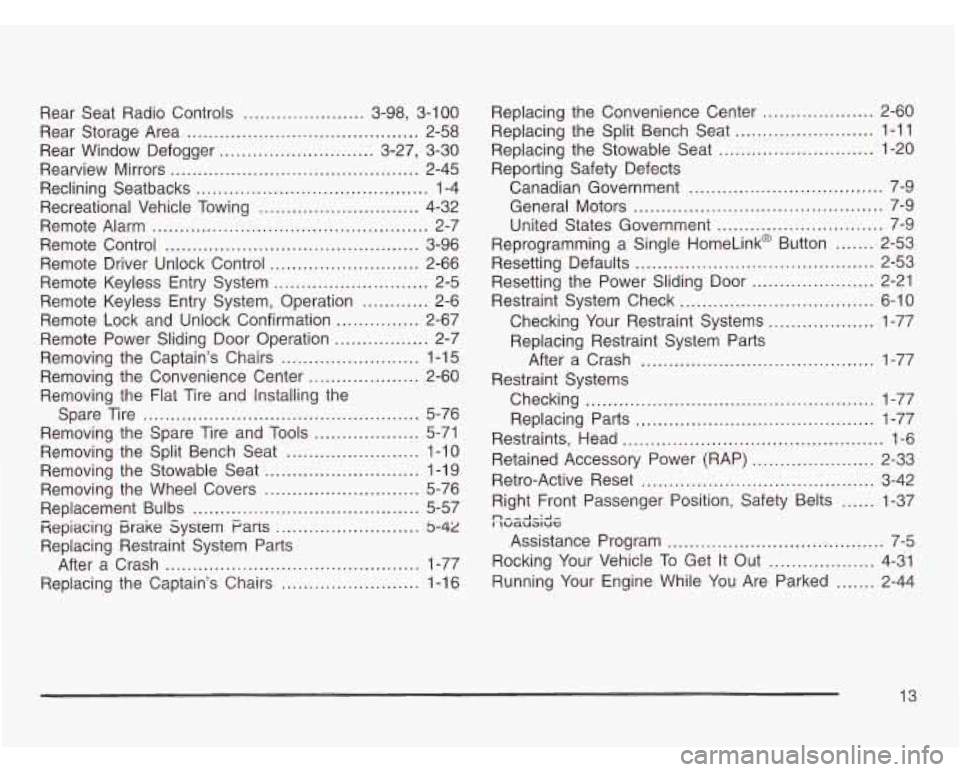
Rear Seat Radio Controls ...................... 3-98, 3-100
Rear Storage Area
.......................................... 2-58
Rear Window Defogger
............................ 3-27, 3-30
Rearview Mirrors
............................................. 2-45
Reclining Seatbacks
.......................................... 1-4
Recreational Vehicle Towing
............................. 4-32
Remote Alarm
.................................................. 2-7
Remote Control
.............................................. 3-96
Remote Driver Unlock Control
........................... 2-66
Remote Keyless Entry System
............................ 2-5
Remote Keyless Entry System, Operation
............ 2-6
Remote Lock and Unlock Confirmation
............... 2-67
Remote Power Sliding Door Operation
................. 2-7
Removing the Captain’s Chairs
......................... 1-15
Removing the Convenience Center
.................... 2-60
iiert-rouiny
the Fiat Tire and insiaiiing the
Spare Tire
.................................................. 5-76
Removing the Spare Tire and
Tools ................... 5-71
Removing the Split Bench Seat
........................ 1-10
Removing the Stowable Seat
............................ 1-1 9
Removing the Wheel Covers
............................ 5-76
Replacement Bulbs
......................................... 5-57
Fiepiacing i3rake System
Faris .......................... 5-42
Replacing Restraint System Parts
After a Crash
.............................................. 1-77
Replacing the Captain’s Chairs
........... ... 1-16 Replacing
the Convenience Center
.... .... 2-60
Replacing the Stowable Seat
........................ 1-20
Reporting Safety Defects Canadian Government
................................... 7-9
General Motors
............................................. 7-9
United States Government
.............................. 7-9
Reprogramming a Single HomeLink@ Button
....... 2-53
Resetting Defaults
........................................... 2-53
Resetting the Power Sliding Door
...................... 2-21
Replacing
the Split Bench Seat
............. .... 1-11
Restraint System Check
................................... 6-10
Checking Your Restraint Systems
.... .... 1-77
Replacing Restraint System Parts
After a Crash
.......................................... 1-77
Checking
.................................................... 1-77
Replacing Parts
........................................... 1-77
Restraints, Head
............................................... 1-6
Retained Accessory Power (RAP)
...................... 2-33
Retro-Active Reset
.......................................... 3-42
Right Front Passenger Position, Safety Belts
...... 1-37
Assistance Program
....................................... 7-5
Rocking Your Vehicle To Get
It Out ................... 4-31
Running Your Engine While You Are Parked
....... 2-44
Restraint
Systems
n--A-. A- 1r1uaua1uc
13